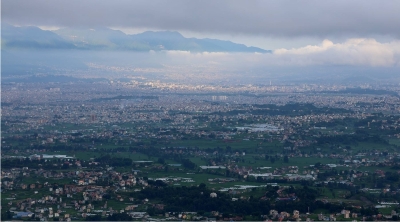Risking Beijing's ire, Vietnam begins dredging on South China Sea reef
SYDNEY/HONG KONG: Vietnam has begun dredging work on a disputed reef in the South China Sea, satellite imagery shows, the latest move by the Communist state to bolster its claims in the strategic waterway.
Activity visible on Ladd Reef in the Spratly Islands could anger Hanoi's main South China Sea rival, Beijing, which claims sovereignty over the group and most of the resource-rich sea.
Ladd Reef, on the southwestern fringe of the Spratlys, is completely submerged at high tide but has a lighthouse and an outpost housing a small contingent of Vietnamese soldiers. The reef is also claimed by Taiwan.
In an image taken on November 30 and provided by US-based satellite firm Planet Labs, several vessels can be seen in a newly dug channel between the lagoon and open sea.
While the purpose of the activity cannot be determined for certain, analysts say similar dredging work has been the precursor to more extensive construction on other reefs.
"We can see that, in this environment, Vietnam's strategic mistrust is total ... and they are rapidly improving their defenses," said Trevor Hollingsbee, a retired naval intelligence analyst with Britain's defense ministry.
"They're doing everything they can to fix any vulnerabilities - and that outpost at Ladd Reef does look a vulnerability."
Reuters reported in August that Vietnam had fortified several islands with mobile rocket artillery launchers capable of striking China's holdings across the vital trade route.
Vietnam's foreign ministry did not respond to a request for comment.
The vessels at Ladd Reef cannot be identified in the images, but Vietnam would be extremely unlikely to allow another country to challenge its control of the reef.
Greg Poling, a South China Sea expert at Washington's Center for Strategic and International Studies (CSIS), said it remained unclear how far the work on Ladd Reef would go. Rather than a reclamation and a base, it could be an attempt to simply boost access for supply ships and fishing boats.
Ladd could also theoretically play a role in helping to defend Vietnam's nearby holding of Spratly Island, where a runway is being improved and new hangars built, he said.
"Vietnam's knows it can't compete with China but it does want to improve its ability to keep an eye on them," Poling said.
Vietnam has long been fearful of renewed Chinese military action to drive it off its 21 holdings in the Spratlys - worries that have escalated amid Beijing's build-up and its anger at the recent Philippines legal action challenging its claims.
China occupied its first Spratlys possessions after a sea battle against Vietnam's then-weak navy in 1988. Vietnam said 64 soldiers were killed as they tried to protect a flag on South Johnson reef - an incident still acutely felt in Hanoi.
BUILDING BURST
The United States has repeatedly called on claimants to avoid actions that increase tensions in the South China Sea, through which some $5 trillion in world trade is shipped every year.
A spokeswoman for the US State Department, Anna Richey-Allen, said it was aware of reports of reclamation work by Vietnam and said the United States regularly raised concerns about such activity by claimants.
"We’ve consistently warned that reclamation and militarization in contested areas of the South China Sea will risk driving a destabilizing and escalatory trend," she said. "We encourage all claimants to take steps to lower tensions and peacefully resolve differences."
Vietnam has emerged as China's main rival in the South China Sea, actively asserting sovereignty over both the Paracel and the Spratly groupings in their entirety and undergoing its own naval modernization. Taiwan also claims both, but its position is historically aligned with Beijing's.
The Asia Maritime Transparency Initiative, run by the CSIS, says Vietnam has added about 120 acres (49 hectares) of land to its South China Sea holdings in recent years.
Regional military attaches say Vietnam's key holdings are well fortified, some with tunnels and bunkers, appearing geared to deterring easy invasion.
Vietnam's reclamation work remains modest by Chinese standards, however.
The United States, which has criticized China for militarizing the waterway, estimates Beijing has added more than 3,200 acres (1,300 hectares) of land on seven features in the South China Sea over the past three years, building runways, ports, aircraft hangars and communications equipment.
Beijing says it is entitled to "limited and necessary self-defensive facilities" on its territory and has reacted angrily to "freedom of navigation" operations by US warships near Chinese-held islands.
CHINESE RECLAMATION WORK DAMAGED
In another image provided by Planet Labs, reclamation work in the Chinese-held Paracel Island chain appears to have been damaged by recent storms.
China began dredging and land filling earlier this year at North Island, about 12 km (7 miles) north of Woody Island, where it has a large military base and this year stationed surface-to-air missiles.
Satellite images in February and March showed dredging vessels working to build a 700-meter (2,300 ft) sand bridge connecting low-lying North Island with neighboring Middle Island.
But images taken after two powerful storms spun through the region in October show the narrow sand strip has been largely swept away.
The Paracels have been under Chinese control for more than 40 years after a battle towards the end of the Vietnam War, when Chinese forces removed the then-South Vietnamese navy. Analysts say they play a key part in protecting China's nuclear armed submarine fleet on Hainan Island, to the north.
China has not commented publicly on the work at North Island and the foreign ministry did not respond to requests for comment.






